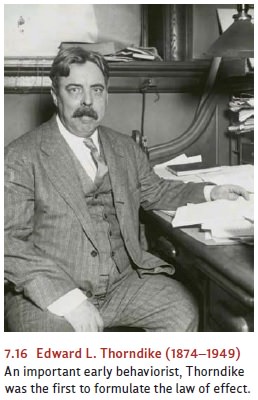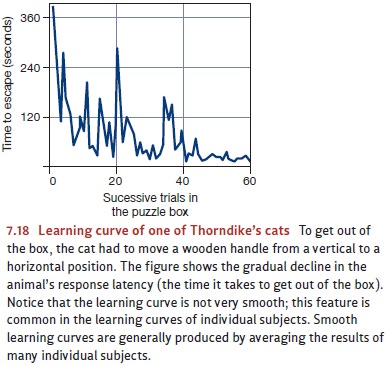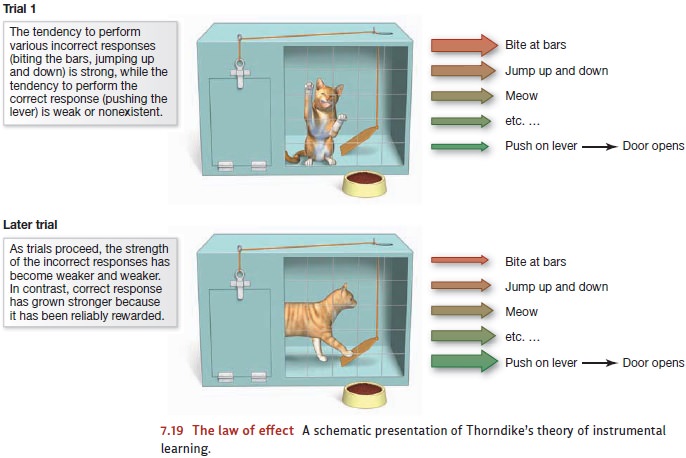Chapter: Psychology: Learning
Instrumental Conditioning: Thorndike and the Law of Effect
Thorndike and the Law of Effect
The experimental study of
instrumental conditioning began a century ago and was sparked by the debate
over Darwin’s theory of evolution by natural selection. Supporters of Darwin’s
theory emphasized the continuity among species, both living and extinct:
Despite their apparent differences, a bird’s wing, a whale’s fin, and a human
arm, for example, all have the same basic bone structure; this similarity makes
it plausi-ble that these diverse organisms all descended, by a series of
incremental steps, from common ancestors. But opponents of Darwin’s theory
pointed to something they per-ceived as the crucial discontinuity among
species: the human ability to think and reason—an ability they claimed animals
did not share. Didn’t this ability, unique to our species, require an
altogether different (non-Darwinian) type of explanation?
In response, Darwin and his
colleagues argued that there is, in fact, considerable continuity of mental
prowess across the animal kingdom. Yes, humans are smarter in some ways than
other species; but the differences might be smaller than they initially

seem. In support of this idea,
Darwinian naturalists collected stories about the intellec-tual achievements of
various animals (Darwin, 1871). These stories painted a flattering picture, as
in the reports of cunning cats that scattered breadcrumbs on the lawn to lure
birds into their reach (Romanes, 1882). In many cases, however, it was hard to
tell whether these reports were genuine or just bits of folklore. Even if they
were genuine, it was unclear whether the reports had been polished by the
loving touch of a proud pet owner. What was needed, therefore, was more
objective and better documented research—research that was made possible by a
method described in 1898 by Edward L. Thorndike (1874–1949; Figure 7.16).
CATS IN APUZZLE BOX
Thorndike’s method was to set up
a problem for an animal to solve. In his classic exper-iments, he placed a
hungry cat inside a box with a latched door. The cat could open the door—and
escape from the box—only by performing some simple action such as pulling a
loop of wire or pressing a lever (Figure 7.17); and once outside the box, the
cat was rewarded with a small portion of food. Then the cat was placed back
into the box for another trial so that the procedure could be repeated over and
over until the task of escaping the box was mastered.

On the first trial, the cats had
no notion of how to escape—and so they meowed loudly and clawed and bit at
their surroundings. This continued for several minutes until finally, purely by
accident, the animal hit upon the correct response.
Subsequent trials brought gradual
improvement, and the animal took less and less time to produce the response
that unlocked the door. By the time the train-ing sessions were completed, the
cats’ behavior was almost unrecognizable from what it had been at the start.
When placed in the box, they immediately approached the wire loop or the lever,
yanked it or pressed it with businesslike dispatch, and hurried through the
open door to enjoy the well-deserved reward.
If you observed only the final
performance of these cats, you might well credit the animals with reason or
understanding. But Thorndike argued that the cats solved the problem in a very
different way. As proof, he recorded how much time the cats required on each trial
to escape from the puzzle box, and he charted how these times changed over the
course of learning. Thorndike found that the resulting curves declined quite
gradually as the learning proceeded (Figure 7.18). This isn’t the pattern we
would expect if the cats had achieved some understanding of how to solve the
problem. If they had, their curves would show a sud-den drop at some point in
the training, when they finally got the point. (“Aha!” mut-tered the insightful
cat, “it’s the lever that lets me out,” and henceforth howled and bit

no more.) Instead, these learning
curves suggest that the cats learned to escape in small increments; they
displayed no evidence at all of understanding and certainly no evi-dence of any
sudden insight into the problem’s solution.
THE LAW OF EFFECT
In Thorndike’s procedure, the
cats’ initial responses in the puzzle box—biting at the latch, clawing at the
walls—all led to failure. As the trials proceeded, though, the cats’ tendency
to produce these responses gradually weakened. At the same time, the animals’
tendency to produce the correct response was weak at first; but, over the
trials, this response gradually grew stronger. In Thorndike’s terms, the
correct response was gradually “stamped in,” while futile ones were “stamped
out.”
But what causes this stamping in
or stamping out? Thorndike’s answer was the lawof effect. Its key proposition is that if a response is followed
by a reward, that responsewill be strengthened. If a response is followed by no
reward (or, worse yet, by punish-ment), it will be weakened. In general, the
strength of a response is adjusted according to the response’s consequences
(Figure 7.19). In this view, we do not need to suppose that the cat’s
performance required any sophisticated intellectual processes. We likewise do
not need to assume that the animal noticed a connection between its acts and
the consequences of those acts. All we need to assert is that, if the animal
made a response and a reward followed soon after, that response was more likely
to be performed later.
Notice that Thorndike’s proposal
suggests a clear parallel between how an organism learns during its lifetime
and how species evolve, thanks to the forces of natural selection. In both
cases, variations that “work”—behaviors that lead to successful outcomes, or
individuals with successful adaptations—are kept on. In both cases, variations
that are less successful are weakened or dropped. And, crucially, in both cases

the selection involves no guide
or supervisor to steer the process forward. Instead, selection depends only on
the consequences of actions or adaptations and on whether these serve the organism’s
biological needs or not.
Related Topics